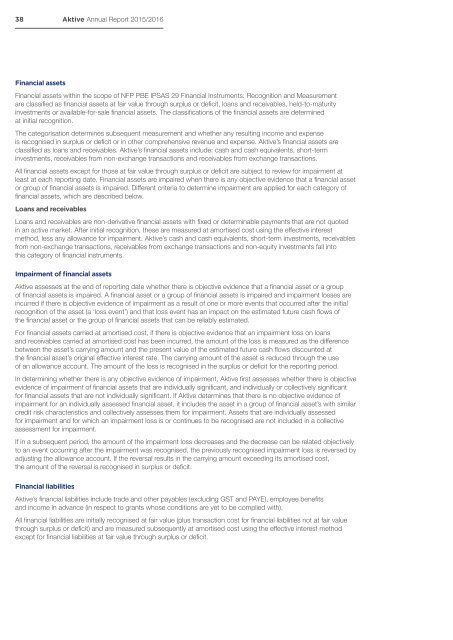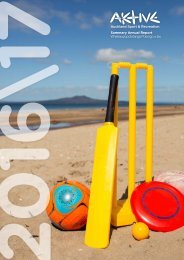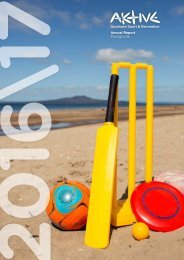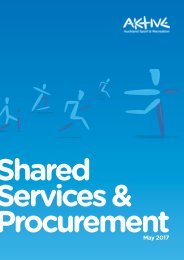Aktive Annual Report 2015/16
Create successful ePaper yourself
Turn your PDF publications into a flip-book with our unique Google optimized e-Paper software.
38 <strong>Aktive</strong> <strong>Annual</strong> <strong>Report</strong> <strong>2015</strong>/20<strong>16</strong><br />
Financial assets<br />
Financial assets within the scope of NFP PBE IPSAS 29 Financial Instruments: Recognition and Measurement<br />
are classified as financial assets at fair value through surplus or deficit, loans and receivables, held-to-maturity<br />
investments or available-for-sale financial assets. The classifications of the financial assets are determined<br />
at initial recognition.<br />
The categorisation determines subsequent measurement and whether any resulting income and expense<br />
is recognised in surplus or deficit or in other comprehensive revenue and expense. <strong>Aktive</strong>’s financial assets are<br />
classified as loans and receivables. <strong>Aktive</strong>’s financial assets include: cash and cash equivalents, short-term<br />
investments, receivables from non-exchange transactions and receivables from exchange transactions.<br />
All financial assets except for those at fair value through surplus or deficit are subject to review for impairment at<br />
least at each reporting date. Financial assets are impaired when there is any objective evidence that a financial asset<br />
or group of financial assets is impaired. Different criteria to determine impairment are applied for each category of<br />
financial assets, which are described below.<br />
Loans and receivables<br />
Loans and receivables are non-derivative financial assets with fixed or determinable payments that are not quoted<br />
in an active market. After initial recognition, these are measured at amortised cost using the effective interest<br />
method, less any allowance for impairment. <strong>Aktive</strong>’s cash and cash equivalents, short-term investments, receivables<br />
from non-exchange transactions, receivables from exchange transactions and non-equity investments fall into<br />
this category of financial instruments.<br />
Impairment of financial assets<br />
<strong>Aktive</strong> assesses at the end of reporting date whether there is objective evidence that a financial asset or a group<br />
of financial assets is impaired. A financial asset or a group of financial assets is impaired and impairment losses are<br />
incurred if there is objective evidence of impairment as a result of one or more events that occurred after the initial<br />
recognition of the asset (a ‘loss event’) and that loss event has an impact on the estimated future cash flows of<br />
the financial asset or the group of financial assets that can be reliably estimated.<br />
For financial assets carried at amortised cost, if there is objective evidence that an impairment loss on loans<br />
and receivables carried at amortised cost has been incurred, the amount of the loss is measured as the difference<br />
between the asset’s carrying amount and the present value of the estimated future cash flows discounted at<br />
the financial asset’s original effective interest rate. The carrying amount of the asset is reduced through the use<br />
of an allowance account. The amount of the loss is recognised in the surplus or deficit for the reporting period.<br />
In determining whether there is any objective evidence of impairment, <strong>Aktive</strong> first assesses whether there is objective<br />
evidence of impairment of financial assets that are individually significant, and individually or collectively significant<br />
for financial assets that are not individually significant. If <strong>Aktive</strong> determines that there is no objective evidence of<br />
impairment for an individually assessed financial asset, it includes the asset in a group of financial asset’s with similar<br />
credit risk characteristics and collectively assesses them for impairment. Assets that are individually assessed<br />
for impairment and for which an impairment loss is or continues to be recognised are not included in a collective<br />
assessment for impairment.<br />
If in a subsequent period, the amount of the impairment loss decreases and the decrease can be related objectively<br />
to an event occurring after the impairment was recognised, the previously recognised impairment loss is reversed by<br />
adjusting the allowance account. If the reversal results in the carrying amount exceeding its amortised cost,<br />
the amount of the reversal is recognised in surplus or deficit.<br />
Financial liabilities<br />
<strong>Aktive</strong>’s financial liabilities include trade and other payables (excluding GST and PAYE), employee benefits<br />
and income in advance (in respect to grants whose conditions are yet to be complied with).<br />
All financial liabilities are initially recognised at fair value (plus transaction cost for financial liabilities not at fair value<br />
through surplus or deficit) and are measured subsequently at amortised cost using the effective interest method<br />
except for financial liabilities at fair value through surplus or deficit.

















